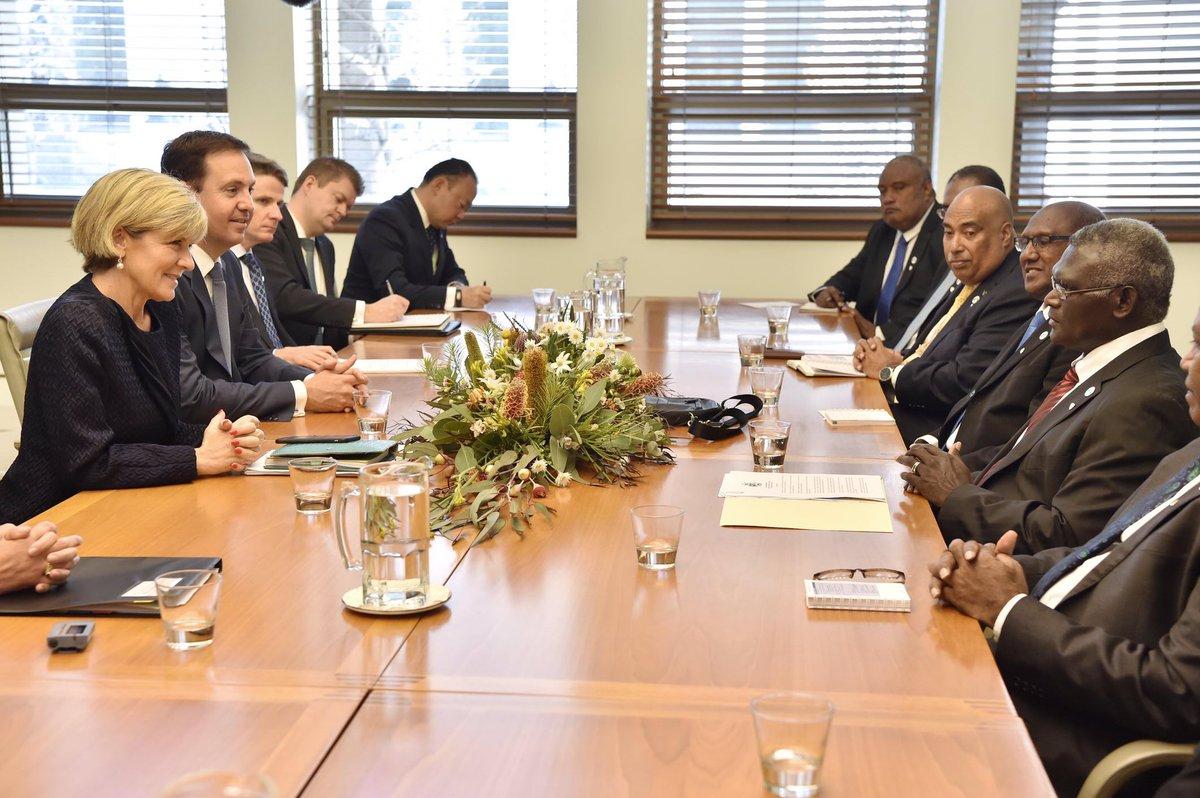What’s the significance of Australia’s new security treaty with Solomon Islands?
Posted By James Batley on December 6, 2017 @ 11:00

The Australian government has tabled the text of the security agreement [1] it signed with (former) Solomon Islands prime minister Manasseh Sogavare during his visit to Australia in August this year. The agreement has been billed as an important confidence-building measure following the conclusion of the 14-year Regional Assistance Mission to Solomon Islands (RAMSI) in June 2017 and the Royal Solomon Islands Police Force’s resumption of responsibility for national security.
The Treaties Committee of the Australian Parliament invited comment on the agreement in October, although it doesn’t appear to have attracted any public submissions, and ratification should be a formality. On the Solomon Islands side, the agreement will need to be ratified by the National Parliament. Sogavare lost office in early November in a vote of no confidence, but his replacement, Rick Hou, is considered sympathetic towards Australia, and the Australian government can be confident that Hou will support ratification.
Throughout RAMSI’s time in Solomon Islands, an international agreement—the ‘RAMSI treaty [2]’—and associated Solomon Islands legislation—the Facilitation of International Assistance Act [3]—governed the mission’s presence. While the act remains in force, the treaty lapsed with RAMSI’s final withdrawal on 30 June 2017.
The preamble of the new treaty notes the two countries’ ‘desire to establish a future basis upon which Australia may provide assistance to Solomon Islands in case of a major security challenge, humanitarian disaster or similar circumstances’. That deliberate open-endedness about the circumstances under which the treaty might come into effect is echoed in Article 2, which outlines the scope of any Australian response. Australia may provide:
- assistance in ‘the provision of safety and security of persons and property’
- humanitarian assistance and disaster response
- ‘such other assistance as may be mutually determined’.
And Article 2.2 states that ‘The parties shall consult on the nature and duration of each deployment, taking into account its particular purpose.’
A key feature of the agreement is that it precludes unilateral action on Australia’s part: Article 2.1 notes that any Australian deployment can take place only ‘[a]t the written request of Solomon Islands’. Nor does the agreement guarantee any response by Australia: Article 2.1 goes on to state that any deployment is ‘subject to Australia’s acceptance of that request based on its assessment of the circumstances’. The agreement doesn’t, therefore, provide a blank cheque to future Solomon Islands governments.
Much of the agreement echoes the language used in the earlier RAMSI treaty, including on carrying and using weapons, and the privileges and immunities of any ‘visiting contingent’. Indeed, the agreement provides for the possibility of an intervention force structured very much along the lines of the RAMSI model, including:
- a head of the visiting contingent with ‘overall responsibility for management of the Visiting Contingent, and for liaising with Solomon Islands’. This is a conscious echo of the role of the RAMSI special coordinator, who wasn’t formally in command of RAMSI’s police and military components but was nonetheless responsible for providing overall coherence to the mission’s strategy and operations. (As an aside, while it’s important not to over-analyse the text, the new agreement differs from the RAMSI treaty in providing for the appointment of the head of the visiting contingent to be notified to the Solomon Islands government. The earlier treaty provided for the appointment to be made in consultation with the Solomon Islands government.)
- an ‘assisting police force’, the commander of which—as in RAMSI—would be appointed as a deputy commissioner of the Solomon Islands Police Force
- an ‘assisting defence force’.
Another important feature of the new agreement is that it explicitly provides for Australia to involve third parties in its response. Again, this reflects one of the key lessons of the RAMSI deployment (and indeed of earlier operations in support of the Bougainville peace process)—that is, the legitimacy bestowed on the intervention by including other Pacific Island countries, as well as New Zealand.
How significant is the new agreement? It isn’t a blank cheque for Australian intervention into Solomon Islands’ affairs, nor does it commit Australia to intervene even if requested to do so. At one level, then, it’s essentially a status of forces agreement (SOFA).
Even so, by the standards of most SOFAs, the new agreement is unusually broad in its scope. In a way, its very open-endedness underlines its significance, particularly bearing in mind Solomon Islands’ troubled history. The agreement isn’t in response to a specific problem; rather, it’s against the possibility of future serious threats to Solomon Islands’ national security and stability. As such, it’s a very clear and practical demonstration of Australia’s intention, as expressed in the 2016 defence white paper [4], to ‘continue to seek to be the principal security partner for Papua New Guinea, Timor-Leste and Pacific Island countries’.
Article printed from The Strategist: https://aspistrategist.ru
URL to article: /whats-the-significance-of-australias-new-security-treaty-with-solomon-islands/
URLs in this post:
[1] security agreement: http://www.austlii.edu.au/au/other/dfat/treaties/ATNIF/2017/34.html
[2] RAMSI treaty: http://www.austlii.edu.au/au/other/dfat/treaties/2003/17.html
[3] Facilitation of International Assistance Act: http://www.paclii.org/cgi-bin/sinodisp/sb/legis/num_act/foiaa2003386/foiaa2003386.html?stem=&synonyms=&query=Facilitation%20of%20international%20assistance
[4] 2016 defence white paper: http://www.defence.gov.au/WhitePaper/Docs/2016-Defence-White-Paper.pdf
Click here to print.